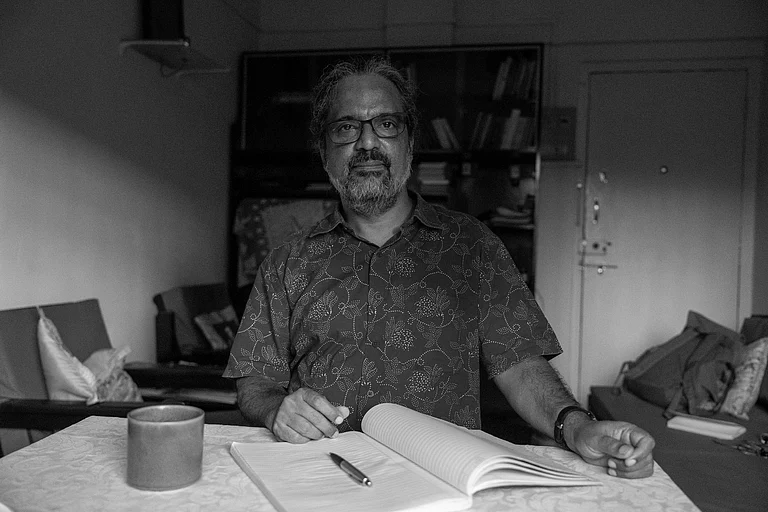Clad in a printed pink synthetic sari, Meena stands listlessly at the entrance of Lane 10 in Kamathipura, mixing tobacco and slaked lime in one hand, observing a couple of drug addicts arguing close by. A pinch of the well-mixed tobacco goes into her mouth. Of indeterminate age, her face may have been an asset a long time ago. A commercial sex worker, Meena was sold to one of the brothels several decades ago. Since then, she has lived in the lanes of Kamathipura, soliciting clients every day. Until last year, she had owned a kholi, but was forced to sell it after a developer forged documents and demanded that she leave.
With no permanent room in the area, she has a tie-up with a lodge owner—a room on a daily rent of Rs 50 per client. Meena does not price herself too high, and earns Rs 150-200 per client. Sometimes, the lodge owner demands free sex. Her story finds an echo across Kamathipura. “They are kicking out all the sex workers from Kamathipura. Anyone who gives us rooms is being harassed by the police. Raids are regularly conducted on the lodges, and cases registered. It is difficult to get kholis here anymore,” says Meena, spitting the tobacco at an already spit-choked corner. Commercial sex workers like Meena are fast becoming casualties of the Maharashtra government’s ambitious redevelopment plan for the area.
The revitalisation of the area and the planned visual shift is focussed on making it more family friendly and commercially mainstream. The redevelopment is aimed at turning the low-rises into spectacular high-rises, with modern architectural designs and state-of-the-art amenities. It is a redevelopment sans any consideration, benefit or housing for commercial sex workers who have given Kamathipura its identity. While once upon a time it had 10,000 sex workers as voters, today their numbers have dwindled to a mere 1,000, of which a small percentage are voters. The loss of voters among them has in a way taken away their rights to housing under the redevelopment plan, the blueprint of which is taking shape in the corridors of power.

Asha Manohar Diwar (60) is a third-generation resident of the over 100-year-old Alishan building, located a few metres away from Meena’s place. “Sex workers have become a very big problem for us. Until some decades ago, they would conduct their business inside their houses. It did not spill out on to the streets. Today, these women are standing on the streets everywhere. This lane is full of liquor shops, drug addicts and sex workers. We are fed up, we want to get out of this place,” says Asha to Outlook.
“Women and girls are the worst sufferers. We can’t go out of our houses, nor can we invite someone to ours. These women have made our lives hell,” lashes out an angry Asha. Her neighbour, Sajida Munshi, too echoes her sentiments. “Our girls are very stressed due to this place. Men follow them thinking they too are sex workers. If we had the money, we would have left Kamathipura long ago. We want these women out. We want redevelopment but without the sex workers. There is no way we can live near them,” says Sajida, who has lived in the building for over three decades.

Though they have co-existed with sex workers in Kamathipura since they were born, the aversion to their presence started after whispers of redevelopment became a reality, say sources. Sensing that this was a chance for a better life from the congested, narrow, noisy, sleazy and seedy lanes of the area, residents have united to force sex workers out, the sources say. “Their penury during the Covid-19 lockdown became an excuse for landlords to forced them out,” a source adds.
Marginalisation of sex workers started after Brihanmumbai Municipal Corporation (BMC) and Maharashtra Housing and Area Development Authority (Mhada) issued eviction notices to residents of dilapidated buildings termed “dangerous”. With residents unwilling to leave, Mhada started “half demolitions”, wherein buildings were razed but their foundations were left intact to prevent encroachments. Many sex workers lost their kholis in this drive. A case in point is the eviction drive at the then dilapidated Moosa building, located in Lane 7. Mhada razed the building, forcing the residents to move to transit accommodation in Chembur, Wadala, Sion and Vikhroli.

This building had 60 flats—40 of which were owned by commercial sex workers and 20 by others who came from Karnataka and Telangana. “There was a “family” sign put up in the areas that belonged to the others. Sex workers had their own rooms, many of which were sub-let to them by tenants. While 15 families were rehabilitated in Kannamwar Nagar in Vikhroli, three were resettled in Prateeksha Nagar in Sion and two in transit accommodation in Chembur. Not a single sex worker was given transit residence despite the fact that they owned rooms in Moosa building, said sources.
Ganesh Pujari (34), a former resident of Moosa, lives in the newly built 24-storeyed Nandanvan building at Kannamwar Nagar. There are 140 1BHK flats in this building, with CCTV cameras, open spaces, wide corridors, airy rooms and garbage collectors. It is the new address of all those who have occupied transit accommodation in one-room kholis in dilapidated 3-storeyed houses nearby. Of them, only four families are from the Moosa building. Pujari’s grandparents, who migrated from Karnataka, had settled down in a 180 sq ft room in Moosa in the early 70s.
“Our hearts are linked to Kamathipura, but I’ll have to think hard if I want to move back to that place. Though we co-existed with the sex workers for a major part of our lives, now we can’t. If Kamathipura is redeveloped, it can’t be a place for sex work anymore,” says Pujari, a driver who lives in a 275 sq ft 1BHK flat with his wife and two daughters—a far cry from his previous 180 sq ft room.
His close friend from Moosa building, Deepak Kamble (35), lives in the 24-storey Paradise Towers, a stone’s throw away. Kamble’s family, originally from Belgaum in Karnataka, had lived in Kamathipura for about 100 years—a majority of it being in Moosa. Some months ago, the Kambles—Deepak, his wife Kalpana, daughters Tanushree (10) and Tanishq (5)—moved into their new home, built by Mhada for those from the transit accommodation buildings that face demolition.
“We lived in a crowded and noisy area of Mumbai. When we came to the transit buildings, we could not live with the silence. Everything was very quiet here. There is no interaction with neighbours,” says Kamble to Outlook. Will he go back to a redeveloped Kamathipura? “The redevelopment will take years. If we accept ownership of this flat, we will not get a flat under the redevelopment project. When we were in school, if we said we lived in Kamathipura, people treated us like outcasts. Redevelopment can only happen without the sex workers. Who will want to live next door to them?” says Kamble.

It is not just the “red light” tag that redevelopment aims to erase, but the name too. The project, to be known as Urban Village—Kamathipura Township—will be completed in six phases, with buildings to relocate tenants and ones that will be put on sale, which will be built in different zones within a complex. The swanky apartment buildings will be high-rises with amenities that Kamathipura’s mostly blue-collared residents have never heard of. “The designs and aesthetics of these proposed buildings will push people of Kamathipura completely away, and there will be segregated zones for the rehabilitated and those who buy the flats at enormous cost,” says Dr Ratoola Kundu, an assistant professor at the Centre for Urban Policy and Governance in Tata Institute of Social Sciences.
According to Kundu, the redevelopment of Kamathipura is a challenge for builders due to the existing sub-tenancy. “There are multiple negotiations going on. There is a need for new housing in this area. People do not want to move from here due to the fear of losing their rights to claims,” says Kundu to Outlook. According to her, it is only after talk of redevelopment started that the stigma of sex trade came to be looked at minutely. “There was always a kind of “live and let live” attitude out there. But the plans for redevelopment have completely broken down this relationship,” she says.
The state government will form a Special Purpose Vehicle in conjunction with Mhada, which will be the nodal agency for Kamathipura. Mhada as facilitator will hire a private developer and take a share of the profits. The Maharashtra government is also seeking help from the UN under its social impact fund for developing countries. Housing minister Jitendra Awhad had told the state legislature in March 2020 that these funds can be used to change Kamathipura’s face.

Flats will be priced at Rs 30,000 per sq ft. This could change depending on real estate prices a decade from now, when the project is expected to be completed, informed Amin Patel, MLA from Mumbadevi that includes Kamathipura. Speaking to Outlook, Patel sounded positive about the redevelopment plan. “There are disputes between landlords and tenants. The landlords have also been tenants once. They do not want to sell, but want to be a part of redevelopment. People want cluster development with amenities. We are in touch with landlords and tenants and are slowly getting everyone under the Kamathipura Punarvikas Samiti,” says Patel. “The state cabinet will take up this issue soon. It is a very viable project,” he says.
Bal Narsaiya Donthula, the chairman of the Samiti—an association of landlords and tenants—says the area must be redeveloped. Secretary of the Samiti, Sachin Kharpeis, is of the opinion that if landlords and tenants unite under one umbrella, they will not be excluded from the benefits of redevelopment. Many landlords admit the size of their properties is too small to get developers interested. But Kamathipura’s central location and connectivity to suburban train stations at Mumbai Central, Grant Road and Byculla give it an advantage.
“If they promise us there will be no sex workers in the redeveloped area, we will consider giving our consent, but it has to be a concrete assurance,” says Sajida. However, it will take some years for the transition from quaint to commercial.
(This appeared in the print edition as "Gentrified Aspirations")
Haima Deshpande in Mumbai


























